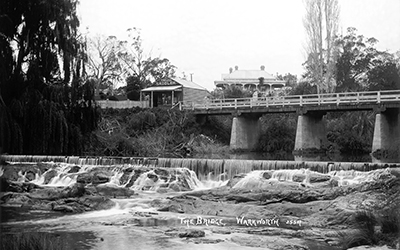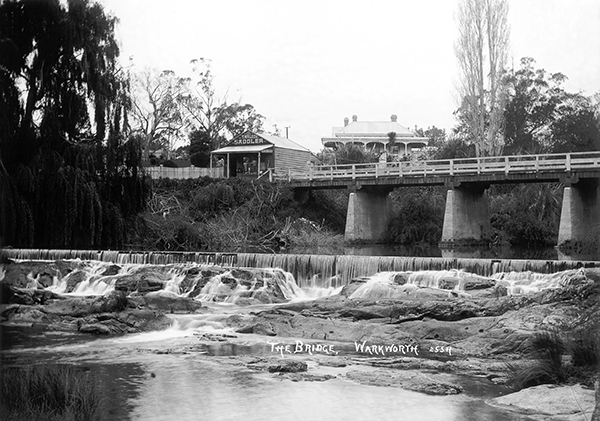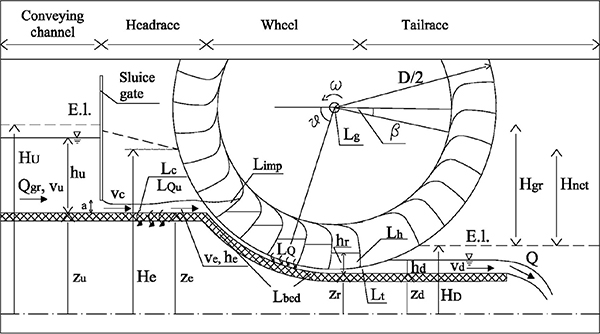Energy and the dammed Mahurangi


Overshadowed: The new Elizabeth Street Bridge is practically on top of the Wilson Cement Works weir, which dates from 1905. In 1914, Wilsons replaced the wooden spans and railings of this bridge with the concrete structure that currently serves some use as a footbridge—its potential positively begs to be developed. image Tudor Washington Collins
Dam the Mahurangi River and generate electricity.
Such a proposal would face fierce opposition. But what if the dam was already in place; built more than a century since…
The damweir is the superior term, given that, as designed, the structure lacks an intentional spillway, otherwise known as the Wilson cement works weir, is located almost beneath the Elizabeth Street Bridge. It was built in 1905 and supplied the works with fresh water for 13 years, before cement production ceased in favour of Portland, Whangārei Harbour. One of the attractions of Portland, aside from limestone richer in calcium than Warkworth’s, was the 2000-kilowatt hydroelectric potential of the Wairua Falls.
For 92 years the Warkworth weir has remained, serving no purpose. Given its location not far upstream from the weir, an understandable misapprehension is that the weir serves the Warkworth water treatment plant. However, there are two natural weirs between the Wilson weir and the point from which the town’s water is abstracted—the Wilson one provides the treatment plant no benefit whatsoever.
Long before atmospheric carbon dioxide was forced on the public consciousness, Aotearoa enjoyed a reputation for clean energy. Sadly, the image of hydroelectric was sullied by a state generator drunk with power and determined to pimp the proceeds of pristine environments for a pittance to any and every profligate consumer from Tiwai Point to the nation’s domestic electric hot water heaters.

Underpowered Undershot: Undershot water wheels are famously underpowered, compared to overshot wheels, which, latterly, were invariably used wherever sufficient head was available. Payback period today would probably at least 14 years, but half that for overshot wheels. As this diagram of a breastshot wheel implies, the mathematics involved in estimating the energy extractable is not trivial. Warkworth’s flourmill, and John Anderson Brown’s sawmill that predated it, situated opposite, on the true left riverbank, were both undershot. diagram Quaranta and Revelli
In 2007, Labour government belated adopted the aim of becoming carbon neutral, by 2020. The incoming National-led government quickly scotched some of the few tawdry measures taken towards that goal, and safeguarded that precious personal freedom: To generate more heat than light, with incandescent light bulbs.
In brief bursts, such as after colossal cloud bursts in the catchment, the Mahurangi could generate the 2000 kilowatts of electricity available at Portland, which William Wilson found so attractive. The ongoing winter generating capacity at the weir, however, would be lucky to be a hundredth of that.
But before sniffing at that figure, it could be 20 very cost-effective kilowatts. Canadian specialist in small-scale solar, wind and hydro power, Energy Alternatives advises:
Our experience has demonstrated that waterpower will produce between 10 and 100 times more power than solar or wind for the same capital investment.
A large part of the potential of a Mahurangi micro hydropower scheme would be in demonstrating a 100% pure use of the electric power. The averaged output—the difference would be exchanged with the national grid—would be ample to charge the batteries of an electric ferry plying between the town and the Wilson Cement Works. This service, along with the long-planned Wilson Cement Works Walkway, would define Warkworth as the staging point for the works heritage site.
Warkworth and the cement works collectively deserve a brighter future than the current car-centric planning. This can be best be advanced by developing the walkway and river ferry infrastructure. Meanwhile, alongside the generator, a fish ladder could be provided.
After a century made more challenging by the Wilson weir, whitebait deserve a leg up.
